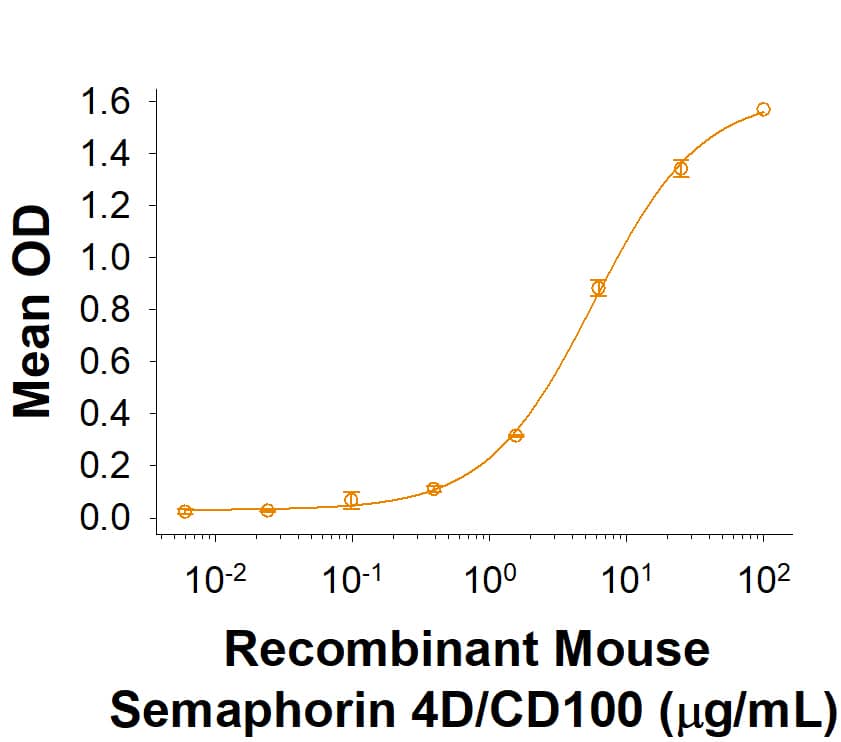Recombinant Mouse Semaphorin 4D/CD100 Fc Chimera Protein, CF
R&D Systems, part of Bio-Techne | Catalog # 5235-S4B

Key Product Details
Source
Accession #
Structure / Form
Conjugate
Applications
Product Specifications
Source
| Mouse Semaphorin 4D/CD100 (Phe24-Met711) Accession # NP_038688.2 |
IEGRMDP | Mouse IgG2a (Glu98-Lys330) |
| N-terminus | C-terminus |
Purity
Endotoxin Level
N-terminal Sequence Analysis
Predicted Molecular Mass
103 kDa
SDS-PAGE
Activity
When Recombinant Human Plexin B2 (Catalog # 5329-PB) is coated at 5 μg/mL, Recombinant Mouse Semaphorin 4D/CD100 Fc Chimera binds with an ED50 of 4-24 μg/mL.
Scientific Data Images for Recombinant Mouse Semaphorin 4D/CD100 Fc Chimera Protein, CF
Recombinant Mouse Semaphorin 4D/CD100 Fc Chimera Protein Binding Activity
When Recombinant Human Plexin B2 (Catalog # 5329-PB) is coated at 5 µg/mL, 100 µL/well, Recombinant Mouse Semaphorin 4D/CD100 Fc Chimera (Catalog # 5235-S4B) binds with an ED50 of 4-24 µg/mL.Formulation, Preparation and Storage
5235-S4B
| Formulation | Supplied as a 0.2 μm filtered solution in Tris and NaCl. |
| Shipping | The product is shipped with dry ice or equivalent. Upon receipt, store it immediately at the temperature recommended below. |
| Stability & Storage | Use a manual defrost freezer and avoid repeated freeze-thaw cycles.
|
Background: Semaphorin 4D/CD100
Semaphorin 4D (Sema4D/CD100, previously sem J, G or C-like 2) is a 150 kDa type I transmembrane glycoprotein of the Class 4 family of transmembrane immune and nervous system semaphorins (1-3). The mouse Sema4D cDNA encodes 861 amino acids (aa) including a 23 aa signal sequence, a 710 aa extracellular domain (ECD) with sema, PSI and immunoglobulin-like domains, a 21 aa transmembrane domain and a 107 aa cytoplasmic domain. Within the ECD portion expressed (aa 24-711), mouse Sema4D shares 93%, 87%, 82% and 78% aa identity with rat, human, porcine and canine Sema4D, respectively. Sema4D is active as a homodimer that occurs via a membrane-proximal intermolecular disulfide (C707) and hydrophobic interactions involving F244 and F246 (4, 5). Proteolysis by metalloproteinases such as TACE/ADAM17 and MMP-14 (MT1-MMP) produces a soluble, active 120 kDa form that is also active as a dimer (5-7). Sema4D, produced by T cells and activated B and dendritic cells, acts through its low affinity receptor CD72 in the immune system (1, 2). CD72 inhibits the antigen presenting cells that express it; this inhibition is relieved by Sema4D binding (8). Sema4D thus causes enhanced B cell survival, differentiation of macrophages and DC, and enhanced T cell antigen priming (2, 8, 9). Sema4D and its high affinity receptor, Plexin B1, are expressed in complimentary patterns in several regions of the brain, and assist in guidance of developing neurons (10). Lower-affinity Sema4D/Plexin B2 binding also enhances neuronal radial and tangential migration (11). Sema4D produced by tumor-associated macrophages binds endothelial cell Plexin B1 to promote tumor angiogenesis, while Sema4D-induced neovascularization and platelet activation is involved in atherosclerosis (3, 6, 7, 12-14). Receptors associated in cis with plexins, such as Met and ErbB2, can alter Sema4D-mediated activities (3).
References
- Furuyama, T. et al. (1996) J. Biol. Chem. 271:33376.
- Kumanogoh, A. and H. Kikutani (2004) Cell. Mol. Life Sci. 61:292.
- Ch’ng, E.S. and A. Kumanogoh (2010) Mol. Cancer 9:251.
- Janssen, B.J.C. et al. (2010) Nature 467:1118.
- Elhabazi, A. et al. (2001) J. Immunol. 166:4341.
- Zhu, L. et al. (2007) Proc. Natl. Acad. Sci. USA 104:1621.
- Basile, J.R. et al. (2007) J. Biol. Chem. 282:6899.
- Kumanogoh, A. et al. (2005) Int. Immunol. 17:1277.
- Ishida, I. et al. (2003) Int. Immunol. 15:1027.
- Worzfield, T. et al. (2004) Eur. J. Neurosci. 19:2622.
- Hirschberg, A. et al. (2010) Mol. Cell. Biol. 30:764.
- Sierra, J.R. et al. (2008) J. Exp. Med. 205:1673.
- Yukawa, K. et al. (2010) Int. J. Mol. Med. 26:39.
- Zhu, L. et al. (2009) Atheroscler. Thromb. Vasc. Biol. 29:1039.
Alternate Names
Gene Symbol
UniProt
Additional Semaphorin 4D/CD100 Products
Product Documents for Recombinant Mouse Semaphorin 4D/CD100 Fc Chimera Protein, CF
Product Specific Notices for Recombinant Mouse Semaphorin 4D/CD100 Fc Chimera Protein, CF
For research use only
